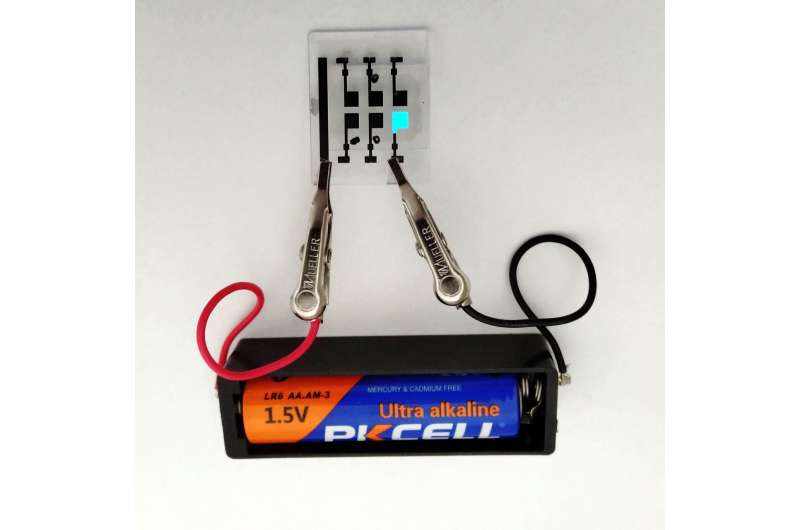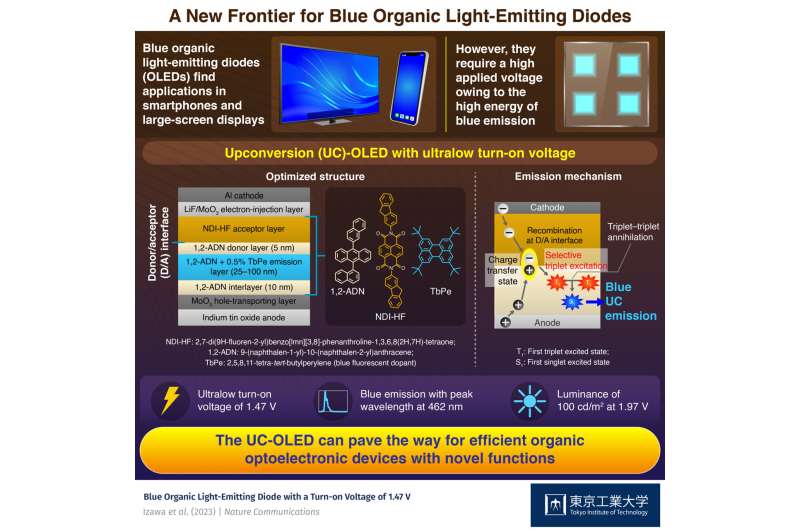This article has been reviewed according to Science X's editorial process and policies. Editors have highlighted the following attributes while ensuring the content's credibility:
fact-checked
peer-reviewed publication
trusted source
proofread
Researchers introduce novel organic light-emitting diode with ultralow turn-on voltage for blue emission

Blue light is vital for light-emitting devices, lighting applications, as well as smartphone screens and large screen displays. However, it is challenging to develop efficient blue organic light-emitting diodes (OLEDs), owing to the high applied voltage required for their function. Conventional blue OLEDs typically require around 4 V for a luminance of 100 cd/m2. This is higher than the industrial target of 3.7 V—the voltage of lithium-ion batteries commonly used in smartphones. Therefore, there is an urgent need to develop novel blue OLEDs that can operate at lower voltages.
In this regard, Associate Professor Seiichiro Izawa from Tokyo Institute of Technology and Osaka University has collaborated with researchers from University of Toyama, Shizuoka University, and the Institute for Molecular Science. The team recently presented a novel OLED device with a remarkable ultralow turn-on voltage of 1.47 V for blue emission and a peak wavelength at 462 nm (2.68 eV). Their work is published in Nature Communications.
The choice of materials used in this OLED significantly influences its turn-on voltage. The device utilizes NDI-HF (2,7-di(9H-fluoren-2-yl)benzo[lmn][3,8]-phenanthroline-1,3,6,8(2H,7H)-tetraone) as the acceptor, 1,2-ADN (9-(naphthalen-1-yl)-10-(naphthalen-2-yl)anthracene) as the donor, and TbPe (2,5,8,11-tetra-tert-butylperylene) as the fluorescent dopant. This OLED operates via a mechanism called upconversion (UC). Herein, holes and electrons are injected into donor (emitter) and acceptor (electron transport) layers, respectively. They recombine at the donor/acceptor (D/A) interface to form a charge transfer (CT) state.
Dr. Izawa observes, "The intermolecular interactions at the D/A interface play a significant role in CT state formation, with stronger interactions yielding superior results."

Subsequently, the energy of the CT state is selectively transferred to the low-energy first triplet excited states of the emitter, which results in blue light emission through the formation of a high-energy first singlet excited state by triplet-triplet annihilation (TTA).
"As the energy of the CT state is much lower than the emitter's bandgap energy, the UC mechanism with TTA significantly decreases the applied voltage required for exciting the emitter. As a result, this UC-OLED reaches a luminance of 100 cd/m2, equivalent to that of a commercial display, at just 1.97 V," explains Dr. Izawa.
In effect, this study efficiently produces a novel OLED, with blue light emission at an ultralow turn-on voltage, using a typical fluorescent emitter widely utilized in commercial displays, thus marking a significant step toward meeting the commercial requirements for blue OLEDs. It emphasizes the importance of optimizing the design of the D/A interface for controlling excitonic processes and holds promise not only for OLEDs, but also for organic photovoltaics and other organic electronic devices.
More information: Blue Organic Light-Emitting Diode with a Turn-on Voltage of 1.47 V, Nature Communications (2023). DOI: 10.1038/s41467-023-41208-7
Journal information: Nature Communications
Provided by Tokyo Institute of Technology





















